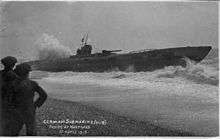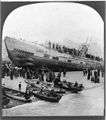SM U-118
SM U-118[Note 1] was a type UE II mine laying submarine of the Imperial German Navy and one of 329 submarines serving with that navy during World War I.
 SM U-118 washed ashore at Hastings, Sussex. | |
| History | |
|---|---|
| Name: | U-118 |
| Ordered: | 27 May 1916 |
| Builder: | AG Vulcan Stettin |
| Launched: | 23 February 1918 |
| Commissioned: | 8 May 1918 |
| Homeport: | Hamburg |
| Fate: | Surrendered on 23 February 1919. Would have been transferred to France, but the tow cable snapped during her voyage to France and she went aground off Hastings on 15 April 1919. She was later broken up. |
| General characteristics [1] | |
| Class and type: | German Type UE II submarine |
| Type: | Coastal minelaying submarine |
| Displacement: |
|
| Length: | 81.52 m (267 ft 5 in) (o/a) |
| Beam: | 7.42 m (24 ft 4 in) |
| Height: | 10.16 m (33 ft 4 in) |
| Draught: | 4.22 m (13 ft 10 in) |
| Installed power: |
|
| Propulsion: | 2 shafts, 2 × 1.61 m (5 ft 3 in) propellers |
| Speed: |
|
| Range: |
|
| Test depth: | 75 m (246 ft) |
| Complement: | 4 officers, 36 enlisted |
| Armament: |
|
| Service record | |
| Part of: |
|
| Commanders: |
|
| Operations: | 1 patrol |
| Victories: | 2 merchant ships sunk (10,439 GRT) |
U-118 engaged in naval warfare and took part in the First Battle of the Atlantic.[3]
Career
SM U-118 was commissioned on 8 May 1918, following her construction at the AG Vulcan Stettin shipyard in Hamburg. She was commanded by Herbert Stohwasser and joined the I Flotilla operating in the eastern Atlantic. After four months without sinking any ships, on 16 September 1918, the SM U-118 scored her first hit. Some 175 miles (282 km) north-west of Cape Villano, the U-118 torpedoed and sank the British steamer Wellington. The following month, on 2 October 1918, she sank her second and last ship, the British tanker Arca at about 40 miles (64 km) north-west of Tory Island.[3] The ending of hostilities on 11 November 1918 led to the subsequent surrender of the Imperial German Navy. The SM U-118 was transferred to France on 23 February 1919.[4]
Beaching at Hastings
U-118 was to be broken up for scrap. In the early hours of 15 April 1919, however, while she was being towed through the English Channel towards Scapa Flow, the dragging hawser broke off in a storm. The submarine ran aground on the beach at Hastings in Sussex at approximately 00:45, directly in front of the Queens Hotel.
Initially, there were attempts to displace the stricken vessel. Three tractors tried to refloat the submarine, and a French destroyer attempted to break the ship apart using her guns.[4] All were unsuccessful, and the closeness of the submarine to the public beach and the Queens Hotel prevented the use of explosives.
The stranded submarine became a popular tourist attraction, and thousands visited Hastings that Easter to see her. She was under the authority of the local coast guard station, and the Admiralty allowed the Town Clerk of Hastings to charge a small fee for visitors to climb on the deck. This went on for two weeks, during which the town gained almost £300 (UK£ 14,700 in 2020) to help fund a welcome for the town's soldiers returning from the war.[4]
Two members of the coast guard, chief boatman William Heard and chief officer W. Moore, showed important visitors around the interior of the submarine. The visits were curtailed in late April, when both coast guard men became severely ill. Rotting food on board was thought to be the cause, but the men's condition persisted and got worse. Moore died in December 1919, followed by Heard in February 1920. An inquest decided that a noxious gas, possibly chlorine released from the submarine's damaged batteries, had caused abscesses on the men's lungs and brain.[4]
Although visits inside the submarine had stopped, tourists still came to be photographed alongside or on the U-boat's deck.[5] Finally, between October and December 1919, U-118 was broken up and sold for scrap.[6] The deck gun was left behind, but was removed in 1921. Some of the ship's keel may yet remain buried in the beach sand.[7]
Gallery
- A postcard showing SM U-118 washed ashore.
 SM U-118 shortly after being beached at Hastings.
SM U-118 shortly after being beached at Hastings. Ground view of SM U-118 in front of the Queen's hotel.
Ground view of SM U-118 in front of the Queen's hotel. SM U-118 crowded with tourists.
SM U-118 crowded with tourists. Aerial view of SM U-118 in front of the Queen's hotel.
Aerial view of SM U-118 in front of the Queen's hotel. SM U-118 being dismantled.
SM U-118 being dismantled.
Summary of raiding history
| Date | Name | Nationality | Tonnage[Note 2] | Fate[8] |
|---|---|---|---|---|
| 16 September 1918 | Wellington | 5,600 | Sunk
5 crew members lost | |
| 2 October 1918 | Arca | 4,839 | Sunk
52 crew members lost |
References
Notes
- "SM" stands for "Seiner Majestät" (English: His Majesty's) and combined with the U for Unterseeboot would be translated as His Majesty's Submarine.
- Tonnages are in gross register tons
Citations
- Gröner 1991, p. 15.
- Helgason, Guðmundur. "WWI U-boat commanders: Herbert Stohwasser". German and Austrian U-boats of World War I - Kaiserliche Marine - Uboat.net. Retrieved 30 April 2016.
- Helgason, Guðmundur. "WWI U-boats: U 118". German and Austrian U-boats of World War I - Kaiserliche Marine - Uboat.net. Retrieved 30 April 2016.
- "U-118". Retrieved 24 January 2010.
- "U-boats". Retrieved 24 January 2010.
- "German Submarine U-118". Retrieved 19 October 2013.
- "Key events 1900 – 1949". Archived from the original on 25 February 2010. Retrieved 24 January 2010.
- Helgason, Guðmundur. "Ships hit by U 118". German and Austrian U-boats of World War I - Kaiserliche Marine - Uboat.net. Retrieved 30 April 2016.
Bibliography
- Gröner, Erich; Jung, Dieter; Maass, Martin (1991). U-boats and Mine Warfare Vessels. German Warships 1815–1945. 2. Translated by Thomas, Keith; Magowan, Rachel. London: Conway Maritime Press. ISBN 0-85177-593-4.
| Wikimedia Commons has media related to SM U 118. |